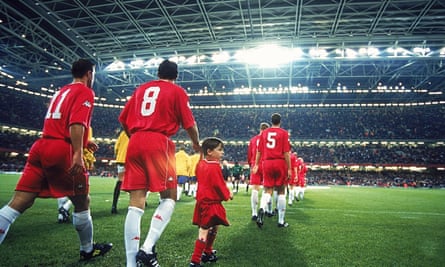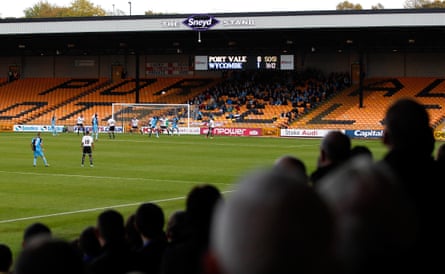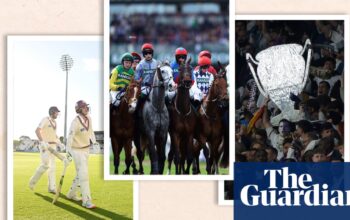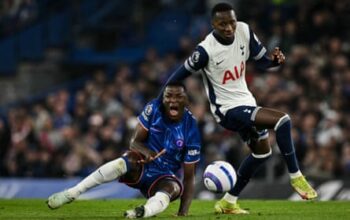“Pakistan caused a stir in the cricket world at the weekend by applying patio heaters and giant fans to the pitch that will be used for the third Test against England at Rawalpindi,” writes Harry Trumpston. “The hope was that this would make the pitch more helpful to the home side’s spin bowlers. What tactics have football clubs used to make their pitches provide more assistance to teams?”
You can’t start this answer anywhere other than with John Beck and his early-1990s Cambridge United side, who rose rapidly from the fourth tier to second and came very close to reaching the top flight with their uncompromising, committed and direct brand of the beautiful game. Beck instructed Cambridge’s ground staff to let the grass grow long in the corners of the Abbey Stadium pitch, so that the ball would sit up on the turf when the U’s got it launched to their wingers … who would, in turn, supply their potent old-school front pairing of Dion Dublin and John Taylor.
The U’s manager was also not averse to holding training sessions in the middle of the pitch to help churn it up, better to thwart opponents that sought to pass it through midfield. It was all part of his attempts at marginal gains long before anyone had heard of Dave Brailsford. Other stunts included turning up the heating in the away dressing room until it was unbearably warm, putting their warm-up balls in the bath so they were heavy with wetness and piling undrinkable amounts of sugar into their tea. “Every single thing you’ve heard from that time was true,” Dublin told the Cambridge News in 2017.
Beck’s antics evidently did not go unnoticed, as Mark Hughes instructed the Millennium Stadium ground staff to similarly let the grass grow on the wings, and narrow the pitch before his Wales side faced Brazil in a friendly in 2000. It didn’t work, as Brazil won 3-0. But narrowing the pitch for perceived tactical advantage has a longer history, Graeme Souness tried it when Rangers took on Dynamo Kyiv in 1987-88 during his famously combative stint as manager at Ibrox. It paid dividends too, Rangers overcoming a 1-0 deficit to beat Valeriy Lobanovskiy’s celebrated side 2-1 on aggregate.

A little less subtle were the antics of Patrik Gunnarsson, goalkeeper for the Norwegian side Viking, who in 2022 was caught on video pulling the goalposts off the ground and closer together, once the assistant referee had completed his pre-match checks. Perhaps he learned the trick from Kim Christensen, with the Gothenburg goalkeeper pictured nudging the goalposts out of position before the game to make his goal less than the regulation eight yards in width. “I got the tip from a goalkeeping friend a few years ago, and since then I have done it from time to time,” Christensen brazenly admitted.
And, of course, there is also the case of the classic Knowledge question about Halifax Town and their apocryphal flamethrower. Any more for any more?
Delivering on stands
“Exeter City’s FA Cup date with Barnet means a stand derby: the Bees sold part of the Hive to the Grecians as part of the redevelopment of St James Park,” notes Stephen Joseph. “Have any other clubs sold parts of their ground to another?”
Paul Levay has an answer in the form of Port Vale. “After Chester City were turfed out of their old Sealand Road ground in the late-1980s, the roof of their main stand found its way to Vale Park, where it was installed in 1992 and, as far as I know, remains today. The mastermind behind this piece of engineering shenanigans was Vale’s then-chairman and local used-car dealer Billy Bell. The stand at the Hamil Road End has had numerous sponsorships and name changes over the years, including a recent swap from the away to the home end, but to fans of a certain generation it will always be affectionately known, ahem, in the chairman’s honour.
“The 1990s were the best period in Vale’s recent history because of the partnership between Bell and legendary manager John Rudge. It’s appropriate you should ask the question this week as, on Monday, a statue in Rudge’s honour was unveiled outside the Hamil Road End of the ground. In fact, if you look closely in some of the photos from the ceremony you can even see the remains of the Sealand Road roof. Further pictures of the roof are here and here.”

But there’s more. “This seems to happen in Scotland more than England,” reckons Jim McEleny. “Greenock Morton bought a stand roof (which was never put back up) and two floodlights (still in use) from St Mirren when they left their Love Street ground. St Mirren’s original floodlights (not the aforementioned) came from Ibrox Park as part of a transfer deal with Rangers. Auchinleck Talbot bought a stand when Hamilton Accies left their ‘old’ Douglas Park ground and took some time to re-erect it as (legend has it that no one recorded what part went where during dismantling). Kilwinning Rangers picked up floodlights from York City’s Bootham Crescent ground and I’m sure they’d previously got them from Manchester United’s old training ground.”
Haaland … denied?
“Erling Haaland has become Norway’s top scorer aged 24,” posts Ben Jones. “Surely a record in the modern era?”
Jack Hayward has come in hot with this one. “As far as I can tell, the player to have become the top goalscorer for a national team at the youngest age is Shalom Luani. Better known for his career in the NFL now, Luani played football in his native American Samoa before moving to the United States to study and play gridiron.
“On 24 November 2011, Luani scored in a 1-1 draw with the Cook Islands. It was his second goal for American Samoa and put him jointly top of the national team’s scoring charts with Ramin Ott. Luani, who was 17 years, three months and 19 days old on the day of the Cook Islands match, had scored his first international goal two days earlier, in the famous 2-1 win over Tonga in 2014 World Cup qualifying. Ott has since scored a third for the country and still holds the national team record, jointly with Samuel Hayward.”
Swede nightmares
“In this season’s Women’s Division 4 in Sweden, Ängelholms FF didn’t just go the whole season unbeaten, but they also didn’t concede a single goal … yet they still finished as runners up,” flags Derek Robertson. “They much surely be the unluckiest – and ‘best’ – runners up of all time?”
Those three draws cost Ängelholm, as Ljungbyhed remarkably pipped them to promotion. Ängelholm (P18 W15 D3 L0 F78 A0) are now embroiled in a playoff to potentially go up after all, taking on Strövelstorps GoIF/IF Salamis from the tier above. The first leg finished … 1-1 after visitors Strövelstorps GoIF/IF Salamis grabbed an equaliser in the 87th minute. Good luck in the return leg, Ängelholm! They wouldn’t, however, be the first team denied despite an unbeaten season.
Knowledge archive
“Footballers are not generally known for their intelligence, and upon reading about David Wetherall, a hero of my childhood, I learned that he attained a BSc in chemistry from the University of Sheffield,” began Karl Corrick in January 2012. “Have any other professional footballers gained degrees, putting paid to the thick-footballer stereotype?”
Honorary degrees don’t count here – Alan Shearer has one, for example – but even without them the list of footballers who have donned the cap and gown is longer than you might think. The aforementioned Wetherall got a first in chemistry, an achievement that former Everton and Wales dog of war Barry Horne matched at the University of Liverpool.
The late Sócrates was a doctor of medicine and philosophy, while the former Ipswich, Watford, QPR and MK Dons defender Steve Palmer has a degree in software engineering from Cambridge. “It was a bit of a novelty for the media when I started but once you cross the line into professional sport you are judged on nothing but your performance,” said Palmer. “My ability to study was perhaps due to the same attributes that allowed me to learn the game.”
Other bright sparks include Steve Heighway (economics), Slaven Bilic (law), Shaka Hislop (mechanical engineering), Iain Dowie (a masters in engineering), Steve Coppell (economics), Richard Hinds (law, Open University), Arsène Wenger (economics), Gudni Bergsson (law) and Oliver Bierhoff (economics).
Update: To this list can now be added Karou Mitoma (dribbling), Giorgio Chiellini (masters in business administration), Stuart Armstrong (law), Romelu Lukaku (public relations and tourism), Simon Mignolet (law and political science), Juan Mata (marketing, then sports science), Mary Earps (management and business studies), Gerard Piqué (masters in business), Duncan Watmore (economics and business management), Vincent Kompany (MBA), Andrés Iniesta (physical activity and sports sciences, then biology), Edwin van der Sar (sports and brand management), and presumably various others we’ve missed.
Can you help?
“With seven London teams and three on the south coast, is this season the least ‘northern’ in English top-flight history?” asks Tim P.
“Which team in the Premier League era has the worst record in lunchtime kick-offs?” wonders Steve Butler. “As a West Ham fan, this question occurred to me around 2pm on Saturday.”
“While on loan at Peterborough from Rotherham last season, Peter Kioso was made club captain,” mails Cameron McGlone. “Is this a common occurrence? What other examples are there of players being made captain (permanently, not just for a game) while on loan?”
“Considering the starting lineup for West Ham against Tottenham, only one starting player had a shirt number in single figures,” writes Paul Turner. “Has a Premier League starting lineup ever been fielded with all players having double-digit squad numbers and what is the largest aggregate number of a starting lineup (West Ham comes in at 241) if you added all squad numbers together?”
-
Mail us your questions or tweet @TheKnowledge_GU
Source: theguardian.com


